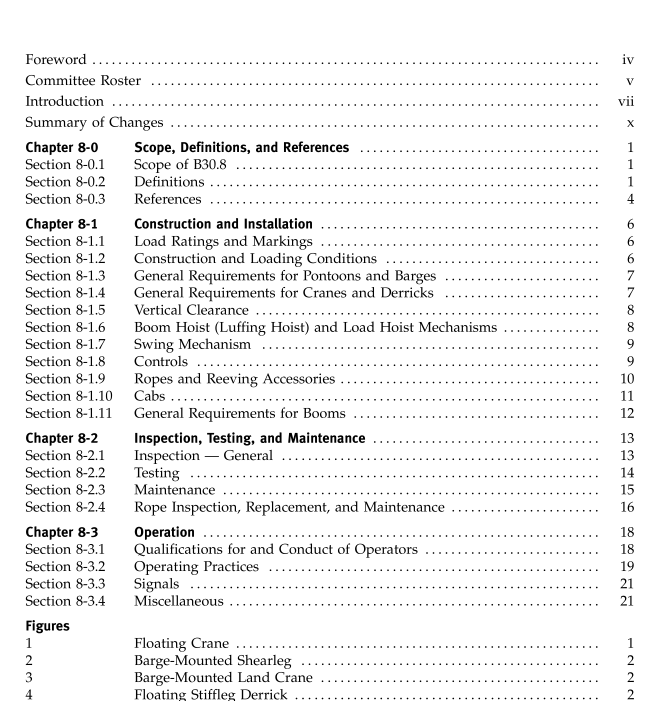ASME B30.8:2004 pdf free download FLOATING CRANES AND FLOATING DERRICKS
If these standards are adopted for governmental use,the references to other national codes and standards inthe specific volumes may be changed to refer to thecorresponding regulations of the governmental author-ities.
The use of cableways, cranes, derricks, hoists, hooks,jacks, and slings is subject to certain hazards that cannotbe met by mechanical means but only by the exerciseof intelligence, care, and common sense. It is thereforeessential to have personnel involved in the use and oper-ation of equipment who are competent, careful, physi-cally and mentally qualified,and trained in the safeoperation of the equipment and the handling of theloads.Serious hazards are overloading, dropping or slip-ping of the load caused by improper hitching or slingingobstructing the free passage of the load, and using equip-ment for a purpose for which it was not intended ordesigned.
The Standards Committee fully realizes the impor-tance of proper design factors, minimum or maximumsizes,and other limiting dimensions of wire rope orchain and their fastenings, sheaves, sprockets,drums,and similar equipment covered by the Standard, all ofwhich are closely connected with safety. Sizes, strengths,and similar criteria depend on many different factors,often varying with the installation and uses.These fac-tors depend on the condition of the equipment or mate-rial; the loads; the acceleration or speed of the ropes,chains, sheaves, sprockets, or drums; the type of attach-ments; the number, size, and arrangement of sheaves orother parts; environmental conditions causing corrosionor wear; and many variables that must be consideredin each individual case. The rules given in the Standardmust be interpreted accordingly, and judgment must beused in determining their application.
The Standards Committee will be glad to receive criti-cisms of this Standard’s requirements and suggestions for its improvement,especially those based on actualexperience in application of the rules.
Suggestions for changes to the Standard should besubmitted to the Secretary of the B30 Committee,ASME,Three Park Avenue, New York, NY 10016-5990, andshould be in accordance with the following format:
(a) Cite the specific paragraph designation of the per-tinent volume.
(b Indicate the suggested change (addition, deletion,revision, etc.).
(c) Briefly state the reason and / or evidence for thesuggested change.
(d) Submit suggested changes to more than one para-graph in the order that the paragraphs appear in thevolume.
The B30 Committee will consider each suggestedchange in a timely manner in accordance with its proce-dures.
SECTION l:SCOPE
This Standard applies to the construction, installation,operation, inspection, maintenance, and safe use of lift-ing equipment used in construction and industrial set-tings.This includes, but is not limited to: articulating-boom, container, gantry, mobile, pedestal, portal, towerand stacker cranes; balance-lifting units; below-the-hooklifting devices; cableways; derricks; jacks; hoists; hooks;loads suspended from rotorcraft; material placementsystems; monorails; rigging hardware; and scrap andmaterial handlers.
This Standard does not apply to track and automotivejacks, railway or automobile wrecking cranes,shipboardcranes,shipboard cargo-handling equipment,well-drilling derricks, skip hoists, mine hoists, truckbody hoists, car or barge pullers, conveyors,excavatingequipment, or equipment falling within the scope of thefollowing Committees: A10,A17,A90,A92,A120,B20,B56, and B77.
SECTION lI:PURPOSE
This Standard is designed to
(a) guard against and minimize injury to workers,and otherwise provide for the protection of life,limb,and property by prescribing safety requirements
(b) provide direction to owners, employers,supervi-sors, and others concerned with, or responsible for,itsapplication
(c) guide governments and other regulatory bodiesin the development, promulgation, and enforcement ofappropriate safety directives
SECTION :INTERPRETATIONS
Upon request, the B30 Committee will render an inter-pretation of any requirement of the Standard.Interpretations can only be rendered in response to awritten request sent to the Secretary of the B30 Commit-tee,ASME,Three Park Avenue,New York,NY 10016-5990.
The request for interpretation should be clear andunambiguous. It is further recommended that theinquirer submit his request utilizing the followingformat.
Subject: Cite the applicable paragraph number(s)
and provide a concise description.
Edition: Cite the applicable edition of the pertinent
volume for which the interpretation is beingrequested.
Question: Phrase the question as a request for an inter-
pretation of a specific requirement suitablefor general understanding and use, not asa request for approval of a proprietarydesign or situation. The inquirer may alsoinclude any plans or drawings that are nec-essary to explain the question; however,they should not contain any proprietarynames or information.
Requests that are not in this format will be rewrittenin this format by the Committee prior to being answered,which could change the intent of the original request.ASME procedures provide for reconsideration of anyinterpretation when or if additional information thatmight affect an interpretation is available. Further, per-sons aggrieved by an interpretation may appeal to thecognizant ASME Committee or Subcommittee. ASMEdoes not “approve,””certify,” “rate,” or “endorse” anyitem, construction, proprietary device, or activity.
ASME B30.8:2004 pdf free download
